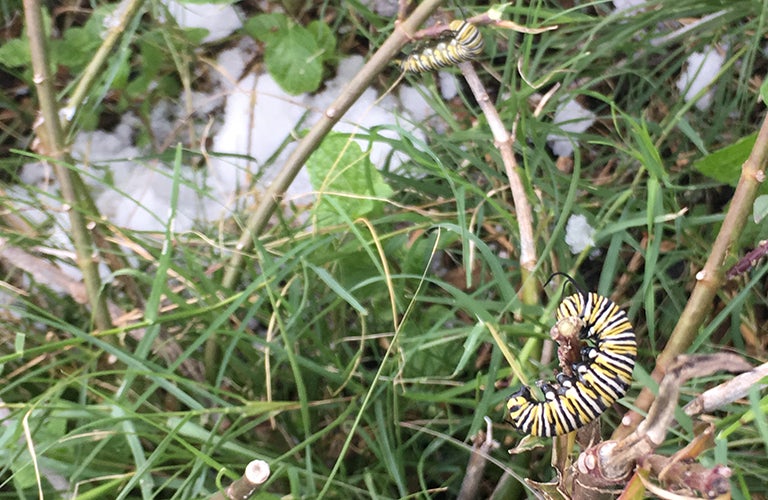Ries Receives Three Grants for Ecological Research

Prof. Leslie Ries is studying how the aftermath of Hurricane Harvey caused changes in monarch butterfly migration and breeding, as evidenced by these caterpillars clinging to milkweed branches as snow coats the ground. (Photo courtesy Leslie Ries)
March 8, 2018 — Professor Leslie Ries of the Georgetown College Department of Biology has been awarded three grants to study the impact of climate change and natural disasters on springtime emergence of plant, bird, and insect species.
The grants, all awarded by the National Science Foundation’s Macrosystems Ecology Panel, will allow Ries’ team to analyze information on the timing and nature of various species’ spring emergences, the migration patterns of monarch butterflies, and the impact of storm-related flooding on monarch butterfly habitats.
AN ACCESSIBLE ICON
According to Ries, the monarch butterfly makes for a great research subject because of its history as a public icon of conservation and its accessibility to average Americans.
“I don’t think there’s a single species that’s as closely monitored as the monarch,” Ries said. “Most of the species that are focused on in conservation efforts are charismatic megafauna, like polar bears or wolves. You don’t actually see those. But you can capture a monarch, bring it home, raise it — people really get involved.”
This accessibility makes it easy for volunteers to participate in citizen science projects, in which researchers like Ries rely on a network of volunteers that provide the observations for their analyses.
“There are people who monitor the migration, people who tag the butterflies, people who look at the eggs as they develop into larvae and pupa, people who sample them for disease,” Ries said. “It’s kind of amazing, and we can use it because it’s so widespread and happens every year.”
Two of the grants Ries’ team has received focus specifically on monarchs to understand what biotic and abiotic factors most influence their annual migrations and population dynamics. Both focus on using volunteer data from across the country as they make their journeys from their northern breeding grounds throughout eastern North America to Mexico. While the butterflies are in many ways a unique species — an insect that conducts a multi-generational annual migration across a continent is a rare thing — their behavior can help scientists understand the changing climate.
“It’s a model system for understanding large-scale ecological patterns, because there’s so much data,” Ries said.
AFTER THE STORM
Funded by a $55,000 grant, Ries will bring her own team to the Houston area to examine how monarch habitats have changed in the wake of Hurricane Harvey, which devastated the region last August.
Storms like this can change when milkweed — monarchs’ host plants — appear, which has repercussions for the butterfly migration that scientists don’t fully understand yet. Precipitation also drives nectar availability in the fall, a critical component of successfully migrating to Mexico.
“We know something unusual was going on this fall that was probably related to the hurricane, but we don’t know yet if it matters,” Ries said.
Ries’ team has begun setting up plots in Texas and examining satellite imagery to determine the distribution of milkweed and is beginning data collection in mid-March. Ries is unsure what exactly she’ll find there, but she suspects the flooding will have mixed effects on monarch habitats.
“The influence on their nectar plants, if any, is probably positive. But the influence on the host plants is probably negative,” Ries said. “Harvey caused more milkweed growth, which prompts the monarchs to interrupt their reproductive cycle and lay eggs in Texas. And those caterpillars won’t survive.”
ECOLOGICAL INTERACTIONS
Another $330,000 grant will allow Ries to study the timing of ecological events, like spring budburst and bird arrival, in a collaboration with Prof. Ali Arab of the Department of Mathematics and Statistics.
“Because there can be differences across groups in reaction to climate change, we’re looking at what happens when the shifts aren’t equal,” Ries said. “If the birds show up and there’s no caterpillars, are they able to be successful? If caterpillars show up when there are no birds, do they do better?”
There is a large existing body of literature on the impact of climate change on individual species’ emergence and some looking at two or three interacting species, but studies that examine how changes in timing of emergence interact have been limited in scope. Ries and Arab’s team hopes to change that.
“When you look at individual species, you’re just asking who’s doing a good job adapting and who’s doing a bad job, and the implications of that are often more straightforward,” Ries. “But when you look at interactions between multiple species, it starts to get more complicated to predict what will happen.”
Once again, she’ll be relying largely on data from citizen science projects, and birds in particular draw large numbers of volunteer data. In one project, Ries and Arab’s team will use data from the past two decades to build models predicting birds’ emergence and distribution based on climate. They’ll attempt to “predict” bird emergence from past years — as far back as 1910 — based on this data.
“It’s a very different climate now, so if these historical model predictions do pretty well, we can be a lot more confident in the predictions we make for the future,” Ries said.
UNDERSTANDING A CHANGING CLIMATE
Ries sees her research as vital in helping people understand the impacts of climate change and major weather events on complex ecological systems.
“Events like Hurricane Harvey are becoming more common and more severe, so we should be considering them in our global ecology model,” Ries said. “At the end of the day, it’s about trying to understand the outcomes of choices we make right now,” Ries said.
— Patrick Curran